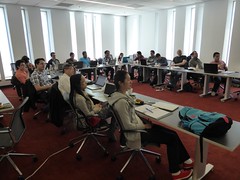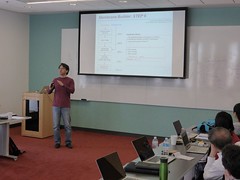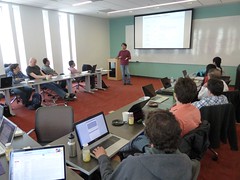This article was originally published at the UChicago Medical Center Science Life blog (link).

The structure of the agitoxin-Shaker channel complex (from Benoit Roux’s lab webpage)
Scientific grants are usually given out one investigator at a time, funding a single laboratory’s research. But as the questions of science grow larger, and the technology needed to answer those questions grows ever more specialized and expensive, funding collaborative grants becomes increasingly common practice. One type of multi-investigator grant has been dubbed a “glue” grant, so named because it sticks together researchers from several different institutions for the common pursuit of one important science goal.
Today, the National Institute of General Medical Sciences announced a glue grant on the topic of membrane proteins, an effort that will be led from right here on the University of Chicago campus. The grant formally creates the Membrane Protein Structural Dynamics Consortium, a team of nearly 30 scientists from 14 institutions in the United States, Germany, Canada, and the Netherlands.
“We have been able to put together almost a dream team of people currently involved in this type of research,” said Eduardo Perozo, PhD, Professor of Biochemistry and Molecular Biophysics at the University of Chicago Medical Center and the leader of the team. “There has been nothing like this project before.”
Membrane proteins are the machines on the factory floor of the cell’s surface, tasked with letting materials in and out of the cell, responding to signals from other cells, and even producing energy. The family includes ion channels that Perozo (and fellow team member Benoit Roux) study, the receptors for neurotransmitters and hormones, and various other pumps, transporters, and exchangers. Figuring out how these miniature machines function will be extremely helpful in designing new drugs, both to treat diseases caused by defective membrane proteins and for improving drugs that rely upon membrane proteins to get to their target.
Traditionally, the study of membrane proteins is bifurcated into those who research their structure and those who research their function. The new glue grant-funded effort will concentrate on the connections between those two fields of study, Perozo said, uniting the best scientists to study membrane protein dynamics.
To do so, the grant will establish communal core facilities at various institutions involved in the consortium, each with their own specialty. For example, one laboratory may create a library of new antibodies useful for experiments, while another laboratory might specialize in imaging techniques such as magnetic resonance or fluorescence spectroscopy, and another offers advanced computation for complex modeling. All of the researchers involved in the effort can then utilize the facilities for their own experiments, with access eventually expanding to the scientific community at large.
“We intend to start with targets for which we know the static structure at high resolutions and the function on a certain level, but don’t know how they connect through dynamics,” Perozo said. “Eventually, we want to develop a set of tools and reagents to be able to engineer or alter normal activity in these systems.”







